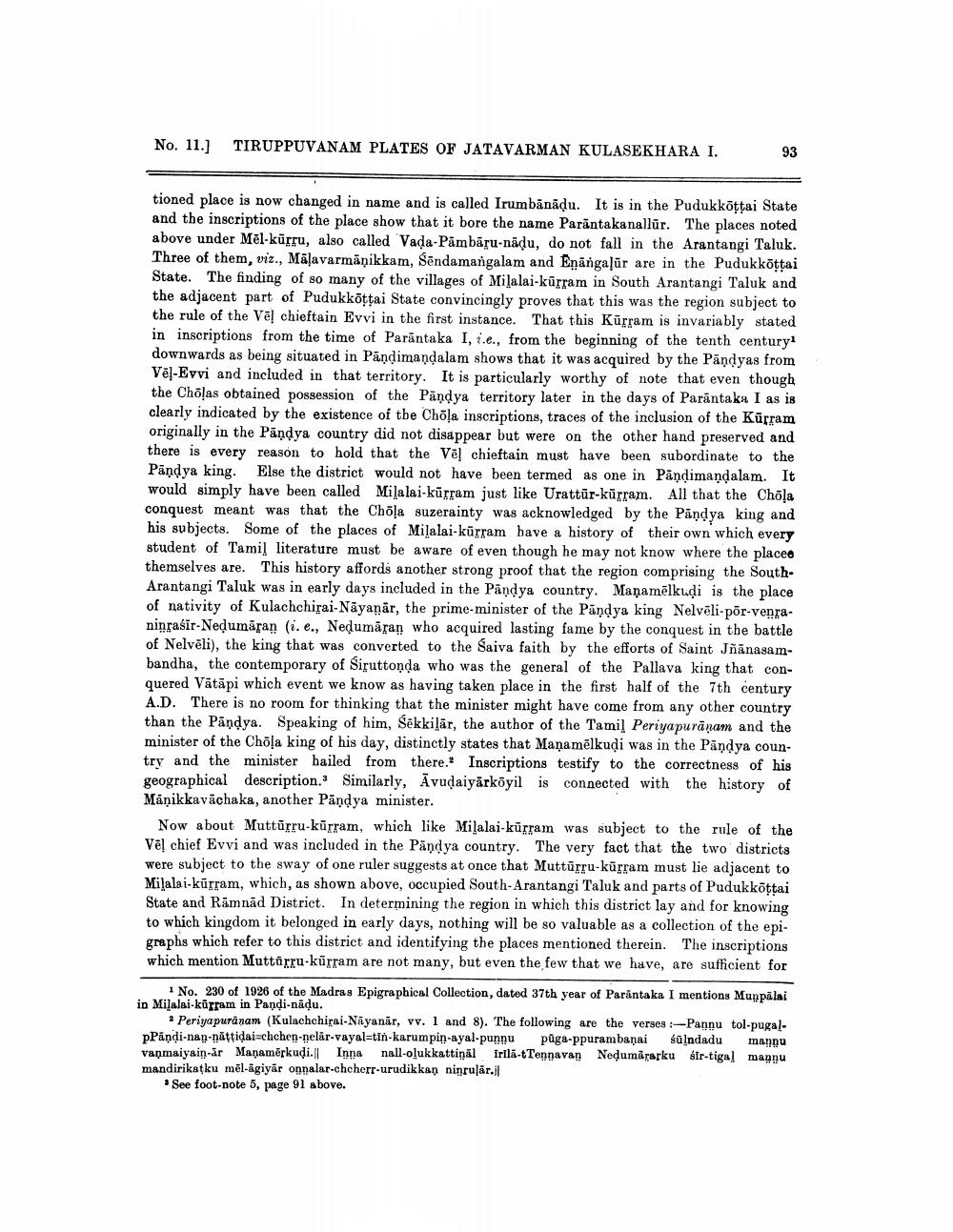________________
No. 11.)
TIRUPPUVANAM PLATES OF JATAVARMAN KULASEKHARA I.
93
tioned place is now changed in name and is called Irumbānādu. It is in the Pudukkottai State and the inscriptions of the place show that it bore the name Parāntakanallur. The places noted above under Mēl-kūrru, also called Vada-Pämbāru-nadu, do not fall in the Arantangi Taluk. Three of them, viz., Māļavarmāņikkam, Sēndamangalam and Enāngaļūr are in the Pudukkottai State. The finding of so many of the villages of Milalai-kūrram in South Arantangi Taluk and the adjacent part of Pudukkottai State convincingly proves that this was the region subject to the rule of the Vēl chieftain Evvi in the first instance. That this Kurram is invariably stated in inscriptions from the time of Parāntaka I, i.e., from the beginning of the tenth century downwards as being situated in Pandimandalam shows that it was acquired by the Pandyas from Vēl-Eyvi and included in that territory. It is particularly worthy of note that even though the Cholas obtained possession of the Pāndya territory later in the days of Parāntaka I as is clearly indicated by the existence of the Chõļa inscriptions, traces of the inclusion of the Kūrram originally in the Pāņdya country did not disappear but were on the other hand preserved and there is every reason to hold that the Vēl chieftain must have been subordinate to the Pāņdya king Else the district would not have been termed as one in Pändimandalam. It would simply have been called Milalai-kūrram just like Urattūr-kūrram. All that the Chola conquest meant was that the Chola suzerainty was acknowledged by the Pāndya king and his subjects. Some of the places of Milalai-kūrram have a history of their own which every student of Tamil literature must be aware of even though he may not know where the place themselves are. This history affords another strong proof that the region comprising the SouthArantangi Taluk was in early days included in the Pandya country. Maņamēlkudi is the place of nativity of Kulachchirai-Nāyaṇār, the prime minister of the Pandya king Nelvēli-põr-venraninraśir-Nedumaran (i. e., Nedumāran who acquired lasting fame by the conquest in the battle of Nelvēli), the king that was converted to the Saiva faith by the efforts of Saint Jñānasambandha, the contemporary of Siruttonda who was the general of the Pallava king that conquered Vätäpi which event we know as having taken place in the first half of the 7th century A.D. There is no room for thinking that the minister might have come from any other country than the Pandya. Speaking of him, Sēkkilār, the author of the Tamil Periyapurānam and the minister of the Chõļa king of his day, distinctly states that Maņamēlkudi was in the Pandya country and the minister hailed from there. Inscriptions testify to the correctness of his geographical description. Similarly, Āvudaiyārköyil is connected with the history of Manikkavichaka, another Pandya minister.
Now about Muttūrru-kurram, which like Milalai-kūrram was subject to the rule of the Vēļ chief Evvi and was included in the Pandya country. The very fact that the two districts were subject to the sway of one ruler suggests at once that Muttūrru-kurram must lie adjacent to Miļalai-kūrram, which, as shown above, occupied South-Arantangi Taluk and parts of Pudukkottai State and Rämnad District. In determining the region in which this district lay and for knowing to which kingdom it belonged in early days, nothing will be so valuable as a collection of the epigraphs which refer to this district and identifying the places mentioned therein. The inscriptions which mention Muttărru-kurram are not many, but even the few that we have, are sufficient for
1 No. 230 of 1926 of the Madras Epigraphical Collection, dated 37th year of Parantaka I mentions Muppālai in Milalai-kurram in Pandi-nadu.
· Periyapuranam (Kulachchirai-Nayanar, vv. 1 and 8). The following are the verses --Pannu tol-pugal. pPándi-nay-nättidai-chchen-nelår-vayal=tin-karumpin-ayal-punnu pūga-ppurambanaisülndadu mannu vanmaiyain-ar Manamērkudi. Inna nall-olukkattiņál irila-t Tennavan Nedumararku sir-tigal magnu mandirikatku měl-agiyar onnalar-chcherr-urudikkan ninrular.il
. See foot-note 5, page 91 above.




